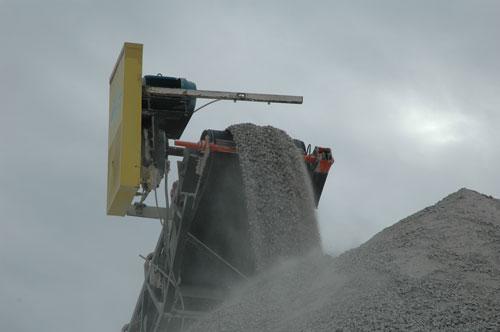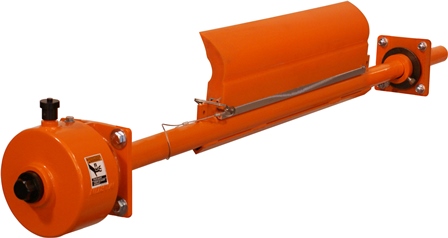Publicado: August 2nd 2016
 North American Limestone Corporation (NALC) is spearheading the Indiana market with high-quality limestone. In 2008, NALC leased a 175-acre tract of humble farm ground in Cloverdale, IN. Today, that property is home to the 243 Complex, NALC’s flagship limestone mining and processing operation. The 243 Complex consists of 243 Lime, a pulverized (or fine grind) limestone operation; 243 Quarry, a crushed limestone operation that, among its traditional rock markets, supplies high-calcium limestone to its sister operation, 243 Lime; and hundreds of acres of additional reserves that will ensure that the facility is producing high quality limestone for decades into the future. The 243 Complex supplies crushed and fine limestone products to a wide range of industries in the Midwest that includes animal feed producers, electric power generation, coal mining, industrial manufacturers and various construction segments.
North American Limestone Corporation (NALC) is spearheading the Indiana market with high-quality limestone. In 2008, NALC leased a 175-acre tract of humble farm ground in Cloverdale, IN. Today, that property is home to the 243 Complex, NALC’s flagship limestone mining and processing operation. The 243 Complex consists of 243 Lime, a pulverized (or fine grind) limestone operation; 243 Quarry, a crushed limestone operation that, among its traditional rock markets, supplies high-calcium limestone to its sister operation, 243 Lime; and hundreds of acres of additional reserves that will ensure that the facility is producing high quality limestone for decades into the future. The 243 Complex supplies crushed and fine limestone products to a wide range of industries in the Midwest that includes animal feed producers, electric power generation, coal mining, industrial manufacturers and various construction segments.
NALC’s focus on reliability is evident throughout their operation, from their mission statement to the large sign indicating that the facility has yet to record a lost time accident. This focus is particularly critical in the animal feed market where NALC supplies calcium carbonate from ground limestone for applications such as poultry grit and calcium supplements for livestock and pet feed. Fittingly, in early December 2012, NALC became the first Indiana supplier feed-grade calcium carbonate to be recognized as a Certified Safe Feed/Safe Food Facility by the American Feed Industry Association.
In order to produce such a wide range of gradations, NALC boasts an expansive series of crushers, mills and screens, all of which must be operated and maintained efficiently in order to preserve their advantaged position in the competitive Indiana market.
One efficiency-gaining method that NALC employs is the use of the Martin® PV primary Cleaner with Twist™ Tensioner on many of its belts throughout the quarry which require moving rock to and from the crusher and also product through its fine grind operation. The different belt applications run between 100 feet per minute to 400 feet per minute, are two ply to four ply, and utilize mechanical splices. With all of these demands, the cleaners are able to effectively remove the residual material. These cleaners use an aggressive angle of attack to the belt for improved cleaning efficiency. The PV Cleaner blades features the company’s patented Constant Angle Radial Pressure (CARP) design for consistent cleaning throughout all stages of blade life. The specially-engineered curved blade maintains the same contact angle, even as the belt wears, helping to retain cleaning efficiency and allows for residual material fines on the belt to be deposited back into the material flow and not underneath the conveyor
This belt cleaner and tensioner combination also helps to eliminate material buildup on the return rollers, which can get trapped on the return side of the conveyor belt and cause problems. Carryback material that is deposited under the conveyors has to be constantly shoveled or washed, which requires extensive labor costs. Being a high-volume producer, excessive carryback and spillage buildup could cost the 243 Complex thousands of dollars in lost production. Martin Engineering has been working closely with NALC to mitigate this common hindrance and avoid costly downtime.
At NALC’s 243 Complex, a significant amount of material was being carried back along the underside of the conveyors. This carryback would accumulate and create mounds of spillage that would pile up in excess amounts causing operational issues. For safety reasons and to increase production, the crews were required to shovel and wash carryback spillage daily meaning costly and time-consuming clean-ups. Thus, worker fatigue was increased and productivity was decreased because at least two hours of everyday was being spent cleaning by the quarry’s maintenance crew.
According to NALC’s Vice President of Operations, Dana Boyd, “carryback and spillage are common problems within our industry, but they can be minimized by installing good cleaners on your conveyor belts. If not addressed, not only does it create safety hazards but, it also creates unnecessary work for the maintenance team when they could be focusing on other priorities.” Boyd is a seasoned aggregates industry operator with over 25 years of experience.
NALC has found that the Martin® PV cleaner with Twist™ Tensioner, almost completely eliminates carryback and spillage. The Martin® Twist™ Tensioner supplies consistent pressure to keep the blade against the belt for effective cleaning, regardless of the state of blade wear, with minimal re-tensioning required. While the Martin® PV Cleaner was engineered specifically for the aggregate industry, it has a durable, one-piece blade that contains approximately 20 percent more urethane than comparable primary cleaners, yielding a longer life in challenging service conditions. This aggressive design for quarry and gravel applications is able to remove even wet, sticky sand from belts 18-72 inches (450-1800 mm) wide.
According to the belt maintenance crews, the time and cost savings is an immediate return on the investment.
Another important discovery with this cleaning unit, according to NALC, is that the mechanical splices installed within the belts are able to run smoothly past without any damage to the cleaner or belt. The tensioner allows for the passing of the mechanical splices.
A true test of Martin’s cleaning system came about just recently when a Christmas blizzard dumped a foot of snow and ice on the quarry. Despite the extreme operating conditions experienced during and after the storm, material continued to run smoothly on NALC’s belts without problems of carryback or spillage. “Other than having to make a few small adjustments to the tensioner and knocking some ice off of the blade, which took one crew member just a few minutes, our belts ran smoothly throughout the blizzard. This was crucial in enabling us to keep up with our aggressive winter production schedule.” said Boyd.
Now that the maintenance crew is spending a lot less time cleaning up, they are spending more time focusing on other tasks. “Our maintenance crews have crucial functions they need to address to keep the plant running,” said Boyd. “Not having to worry about carryback and spillage during these times is important.” The cleaners and tensioners have been on the belts since March 2012, and, since installation, they have not had to replace the blades, and as Boyd stated earlier, they have only had to make minor adjustments to eliminate their carryback and spillage – a true cost savings.
 Quick Facts about NALC’s 243 Complex
Quick Facts about NALC’s 243 Complex
- The 243 Complex supplies crushed and fine limestone products to a wide range of industries in the Midwest that includes animal feed producers, electric power generation, coal mining, industrial manufacturers and various construction segment.
- NALC is the first and currently the only Indiana supplier feed-grade calcium carbonate to be recognized as a Certified Safe Feed/Safe Food Facility by the American Feed Industry Association.
- The 243 Complex supplies high-calcium limestone that is also approved for Indiana Department of Transportation (INDOT) applications.
Quick Facts about Martin® PV Cleaner
- One-piece blade contains approximately 20 percent more urethane than comparable primary cleaners, extending service life.
- Uses an aggressive angle of attack to the belt to increase cleaning efficiency.
- Allows "one-pin, no-tool" blade replacement. Drop the sturdy blade into place on the reinforced steel mainframe and secure it with a wire lock pin.
- Economical assembly including mainframe, urethane blade and tensioner.
Quick Facts about Twist™ Tensioner
- The Martin® Twist™ Tensioner can be used on either primary cleaners or secondary cleaners.
- Twist the tensioning gear the specified number of notches (determined by belt width). Ratchet will automatically lock in place.
- If blades pull through, the tensioner's coupling rolls over, releasing pressure and reducing the risk of harm to personnel or equipment.
- Light aluminum housing and the fully enclosed design keeps the tensioner mechanism clean.
 Quick Facts about NALC’s 243 Complex
Quick Facts about NALC’s 243 Complex